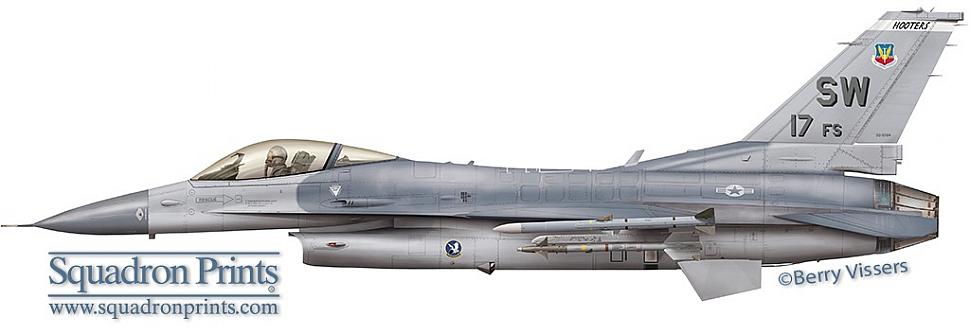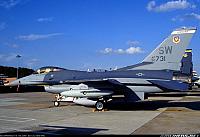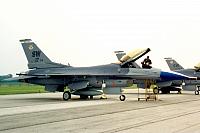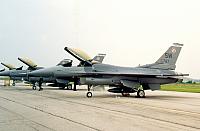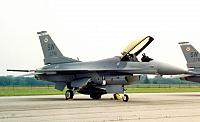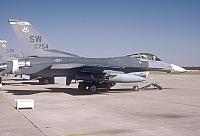 |
17th Fighter Squadron ( USAF ACC)" Hooters" |
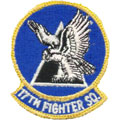 |
17 FS " Hooters" ( USAF ACC) | |||
| Status: |
Disbanded
|
|||
| Version: | F-16C/D block 42 | |||
| Role: | Attack | |||
| Tailband: | White | |||
| Motto: | N/A | |||
| Badge: | N/A | |||
|
Disbanded on December 31st, 1993.
|
||||
F-16 History
The 17th TFS started receiving the first F-16s in 1981. It was reactivated as an F-16 squadron and based at Shaw AFB. The first aircraft were of the block 10 version, but soon afterwards – in 1982 – the first block 15 airframes started to arrive. The responsibilities of the 17th TFS was close air support, air interdiction, an anti-ship mission armed reconnaissance to support worldwide contingencies. For the anti-ship mission the squadron was equiped with the AGM-65 "Maverick" missile.
In 1985 the squadron shifted block type once more. This time the squadron received brand-new block 25 airframes from the General Dynamics factory in Fort Worth. These aircraft were more capable in comparison with the former block 15 airframes. Also new weapon systems could now be introduced, like the CBU-87 Wind Corrected Munition Dispensers (WCMD).
During 1990 the tensions in the Middle East started rising. Therefore the squadron deployed to United Arab Emirates and started flying air defense missions over the Gulf region. When Operation Desert Storm started in January of 1991 the squadron was at the forefront of air operations operating from Al Dhafra AB in the United Arab Emirates.
Upon their return the squadron started receiving some brand-new block 42 airframes. Their primary mission of air interdiction remained the same. During 1993 the first rumors came that the entire wing was to be disbanded. The news was quickly acknowledged. On December 31st, 1993 the squadron was disbanded in favor of units from the 20th FW. The reason behind the disbandment was to keep the history alive of the 20th FW and its resident squadrons over those of the 363rd FW.
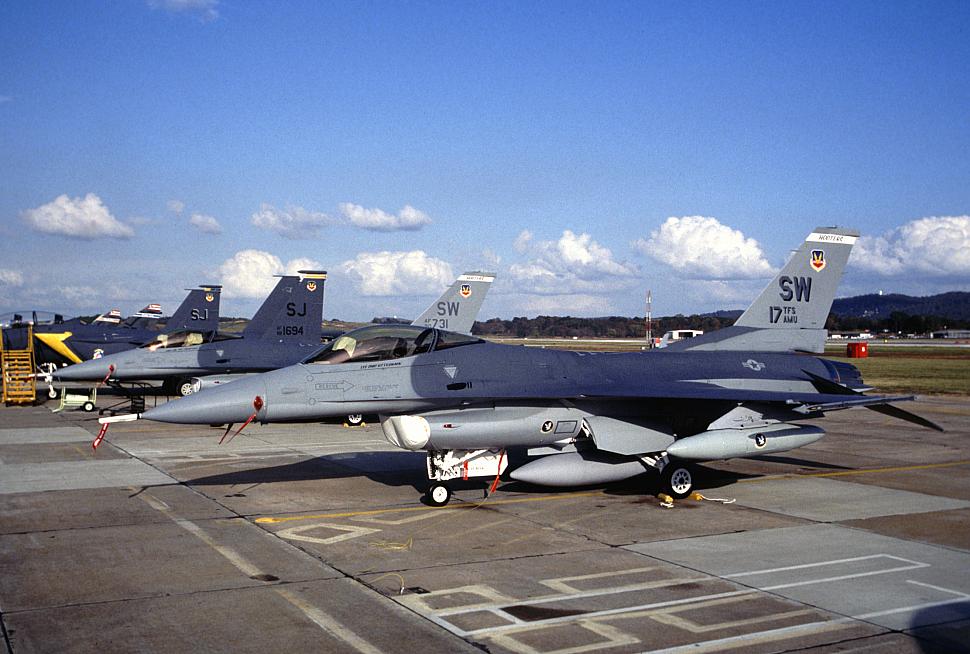
Aircraft Markings History
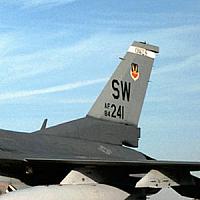
The tail consists of a white tailband with the word 'Owls' included. The 'SW' tailcode (for Shaw) is in the center of the tail with the Tactical Air Command - and later Air Combat Command - logo in between them. The serial is situated on the base of the tail. From 1987 onwards the name was changed to 'Hooters'.
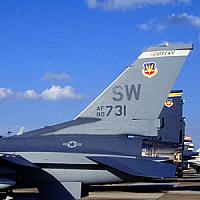
The general lay-out remained the same. The base of the tail was transformed to the standard USAF color scheme.
Unit History
- 1917: Activation of the squadron in Kelly, Texas (as 29 AS)
- 1917: JN-4
- 1917: JN-4 (redesignated 17 AS, Toronto [Can.])
- 1917: JN-4 (Taliaferro Field, Texas)
- 1917: JN-4 (Garden City, New York)
- 1918: Sopwith F-1 'Camel' (part of 65 W [RAF], Petite Synthe [Fr.])
- 1918: Sopwith F-1 'Camel' (part of 13 W [RAF], Auxi-le-Chateau [Fr.])
- 1918: 'Spad' XIII (Soncamp [Fr.])
- 1918: 'Nieuport' 28 (part of 4 PG, Toul [Fr.])
- 1918: 'Spad' XIII (Colombey-les-Belles [Fr.])
- 1919: 'Spad' XIII (Nantes [Fr.])
- 1919: 'Spad' XIII (Garden City, New York)
- 1919: Disbanded
- 1921: Activation of the squadron in Kelly, Texas
- 1921: 'Spad' XIII
- 1921: 'Spad' XIII (Ellington Field, Texas)
- 1922: MB-3 (Selfridge Field, Michigan)
- 1924: PW-8
- 1926: P-1
- 1930: P-12
- 1932: P-6
- 1934: P-26 'Peashooter'
- 1936: P-26 'Peashooter' (part of 1 PG)
- 1938: P-35
- 1940: P-26 'Peashooter' (part of 4 CG, Nichols Field [Phil.])
- 1941: P-35 (part of 24 PG, Bataan [Phil.])
- 1941: P-40 'Warhawk'
- 1946: Disbanded
- 1971: Activation of the squadron in Korat [Thai.]
- 1971: F-105D 'Thunderchief' (part of 388 TFW)
- 1974: Disbanded
- 1981: Activation of the squadron in Shaw, South Carolina
- 1981: F-16A/B 'Fighting Falcon'(part of 363 TFW)
- 1985: F-16C/D 'Fighting Falcon'
- 1991: F-16C/D 'Fighting Falcon'(part of 363 FW)
- 1992: F-16C/D 'Fighting Falcon'(part of 363 OG)
- 1993: Disbanded
Deployments
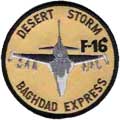 |
' Desert Storm' |
| Al Dhafra AB, UAE (August 9th, 1990 to March 13th, 1991) | |
| Operations for the 17th TFS started in Al Dhafa AB. UAE with a deployment to defend the country from potential Iraqi attacks. With US led invasion in January of 1991 took part in the massive air operations. |
F-16 Airframe Inventory
- All 17 FS F-16s in our F-16 Aircraft Database (past and current aircraft)
- Current 17 FS F-16s in our F-16 Aircraft Database
Photos
Please use this form to add any list any error or omissions you find in the above text.
Note: your comments will be displayed immediately on this page. If you wish to send a private comment to the webmasters, please use the Contact Us link.

